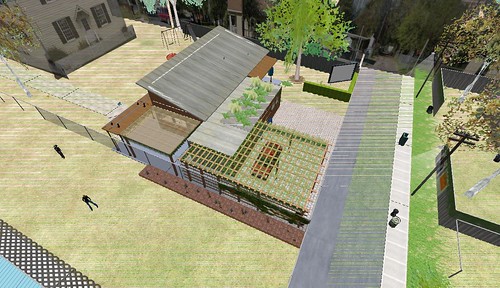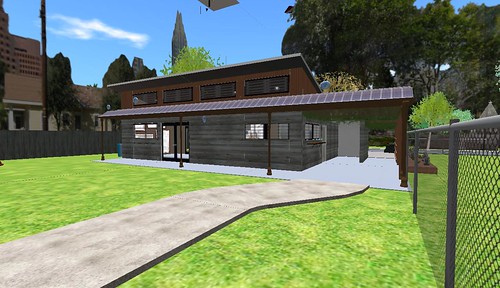If you have any interest or curiosity whatsoever about using Second Life or any other online, 3D, collaborative virtual environment for architectural prototyping or education, this is a must read success story.
Construction has completed on designs first prototyped in Second Life by students at the University of Austin School of Architecture. The prototypes were the result of a collaboration between Professor Sergio Palleroni’s students and the students of Dr. Leslie Jarmon’s “Communicating Across the Disciplines” graduate course. Sadly, Dr. Jarmon, who was responsible for orchestrating the virtual presence for the entire University of Texas system, passed away last year.

Professor Palleroni first described his vision for using Second Life in architectural education during a talk with Autodesk VP Phil Bernstein in an event held in Second Life in late 2007. He had this to say to his students,
“I want ideas (from my students) on how we’re going to use this new Second Life to actually expand our exchange in our community. Becuase, I thought, ‘my God, what a tool – I was so ignorant.’ I was thinking, if I can get people connected, there might be opportunities for these clients that we’re serving, to actually participate in forums here, where I could get some world class people here, and in Second Life we would all be inhabiting the same realm, I think its fantastic.”
2 years later, the project became a virtual reality in Second Life, with several Alley Flats homes prototyped. Upon launching the project, and using it to engage community members, students were equally enthusiastic,
“There’s something extremely ‘right’ about having Alley Flats in Second Life, since Alley Flats is about building community through great design, and the clever use of technology, and that’s what Second Life is all about. I think we’ve achieved something special, and I really hope that it will live long beyond today, and be useful for many communities all around the world.”
“This will bring people together from from different disciplines, and one of the greatest lessons I’ve learned from this project was how relevant Second Life is in both commercial and non-profit markets, and I think its going to be the next huge thing in the industry.”
A Phd student in molecular biology added this,
“Working with this class was a wonderful experience, very different from working in a lab. It was enjoyable to work across disciplines, and working on this project has provided many opportunities to engage and adapt my communication skills, and because of this, I have gained new perspectives on diversity and teamwork.”
During the launch, Sergio added some insightful remarks,
“I never thought that I would be building in a virtual world, and though I was skeptical, I’m now beginning to become a believer. I think that at the heart of this, and what unites the real and the virtual world, is the idea that we all share aspirations and ideals that we cannot make possible within any other construct, and so the fact that we are able to, here in Second Life, see how a city can begin go change, and we can actually show people.. and its fantastic, because we can begin to let people understand what the future might look like. So I would almost propose that Second Life is not some unreal realm, but in some ways is the future, or a projection of where we’re heading, and a way to dream about the future.”
Dr. Jarmon said,
“Since we started working on this project, so many people have said ‘can we get one, can you build this for us?
Someone asked the students what it was like working in a virtual world. Here’s what they had to say about it:
“We didn’t know what the possibilities of Second Life were, but now we’re standing here, its just amazing – its not something anyone in the group could have imagined, so I think working in a virtual world like this shows us that the possibilities are endless.”
“I thought Second Life, at first, was going to be difficult, but I learned to use it as an adjunct to our ‘normal’ communication. You can’t just show up in a virtual world and expect to get work done. You need to have an agenda and things to do, just like in the real world.”
“I’m a much better salsa dancer in Second Life than I am in the real world – which counts for something. (laughter)”

Sergio added to the student’s comments by saying,
“I can imagine in Second Life we’re going to be able to push this all much more, and actually model, what kind of city can we get form this. I actually see this as a tremendous opportunity, and the kind of space that we all share – so I think we’re going to start using (Second Life) right away.”
Dr. Jarmon concluded with a wish for an ongoing collaboration,
“You know, you teach a class, and your grad students want to keep working after the semester is over – c’mon, that just doesn’t happen very often, so we hope this will continue, Sergio, because this is just a marvelous team.”
